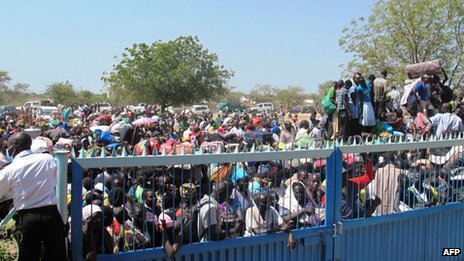
Thousands of people have sought refuge at the UN compound in Bor
South Sudanese troops are preparing to enter the rebel-held town of Bor, President Salva Kiir has said.
Mr Kiir told parliament the army was “ready to move”, adding that the counter-attack had been delayed to allow US citizens to be airlifted out.
Bor, in the restive state of Jonglei, fell to rebels on Wednesday.
A week of ethnic violence has raised fears of civil war. UN humanitarian staff have described bloody scenes, including summary executions.
Earlier the South Sudanese army confirmed that Bentiu, the capital of oil-rich Unity State, had been taken by fighters supporting former vice-president Riek Machar.
President Kiir, a member of the majority Dinka ethnic group, sacked Mr Machar, who is from the Nuer community, in July.
The president has accused Mr Machar of attempting a coup, which he denies.
Mr Machar says the president has been carrying out a purge of his rivals.
Summary execution
A spokesman for the United Nations in the capital, Juba, told the BBC that UN compounds nationwide were sheltering more than 40,000 civilians.

Toby Lanzer: "There was a lot of looting, a lot of gun shots and a lot of dead bodies"
The United Nations Mission in South Sudan has said it will not abandon the civilians.
The spokesman, Joseph Contreas, said the UN was “doing everything possible to remain in touch with key leaders and seek a peaceful way out of the conflict”.
Addressing parliament, President Kiir repeated his offer to hold talks with Mr Machar, saying that a delegation of East African foreign ministers had offered to mediate.
However, he said that Mr Machar would have “to come to the table without any precondition”.
UN humanitarian co-ordinator Toby Lanzer, who was in Bor over the weekend, told the BBC he had witnessed “some of the most horrible things that one can imagine”.
“People who were being lined up and executed in a summary fashion. This is done by people who are simply out of control,” Mr Lanzer told Newshour.
He said an estimated 17,000 people had sought protection in the UN peacekeeping base in Bor.
Aid workers are under intense pressure, with humanitarian compounds looted in several locations.
“We are looking at a massive increase in need and I am engaging all parties to ensure that civilians are protected and that aid workers are able to access people who need our help,” Mr Lanzer said in a statement.
“Humanitarians will continue to stand by the people of South Sudan at this extremely difficult time and provide impartial and neutral aid to save lives and alleviate suffering.”
Over the weekend, the US deployed extra troops to help evacuate Americans and other foreigners.
In Bor, three US military aircraft were fired upon on Saturday, forcing the evacuation to be aborted. On Sunday, the US re-entered using civilian US and UN helicopters.
The UK is sending what is expected to be a final plane on Monday to help Britons flee South Sudan.
Sudan suffered a 22-year civil war that left more than one million people dead before the South became independent in 2011

Sudan's arid north is mainly home to Arabic-speaking Muslims. But in South Sudan there is no dominant culture. The Dinkas and the Nuers are the largest of more than 200 ethnic groups, each with its own languages and traditional beliefs, alongside Christianity and Islam.

Both Sudan and the South are reliant on oil revenue, which accounts for 98% of South Sudan's budget. They have fiercely disagreed over how to divide the oil wealth of the former united state - at one time production was shutdown for more than a year. Some 75% of the oil lies in the South but all the pipelines run north

The two Sudans are very different geographically. The great divide is visible even from space, as this Nasa satellite image shows. The northern states are a blanket of desert, broken only by the fertile Nile corridor. South Sudan is covered by green swathes of grassland, swamps and tropical forest.

After gaining independence in 2011, South Sudan is the world's newest country - and one of its poorest. Figures from 2010 show some 69% of households now have access to clean water - up from 48% in 2006. However, just 2% of households have water on the premises.

Just 29% of children attend primary school in South Sudan - however this is also an improvement on the 16% recorded in 2006. About 32% of primary-age boys attend, while just 25% of girls do. Overall, 64% of children who begin primary school reach the last grade.

Almost 28% of children under the age of five in South Sudan are moderately or severely underweight - this compares with the 33% recorded in 2006. Unity state has the highest proportion of children suffering malnourishment (46%), while Central Equatoria has the lowest (17%).
Who is Riek Machar?

- Central figure in Sudanese and South Sudanese politics for three decades
- Ethnic Nuer – second largest group in South Sudan
- Senior southern rebel SPLM commander but split in 1990s
- After 2005 peace deal appointed vice-president, retaining the post after independence in 2011 until his dismissal in July 2013



Leave a reply